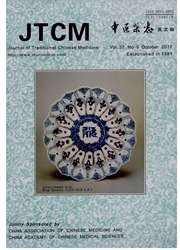

 中文摘要:
中文摘要:
目的:观察滋养肝肾方对绝经期大鼠血清雌二醇(E2)、促卵泡刺激素(FSH)、促黄体生成素(LH)、一氧化氮(NO)及血浆内皮素(ET)及卵巢的影响。方法:12月龄SD雌性清洁级大鼠共50只,阴道脱落细胞镜检筛选出动情周期不规律大鼠40只作为绝经期动物模型,随机数字表法分为模型组,己烯雌酚(DES)组,中药高、低剂量组,另设3月龄雌性大鼠10只为对照组。中药高、低剂量组给予滋养肝肾方水煎剂,剂量分别为59.0、29.5g·kg^-1·d^-1;DES组给予DES药液,剂量为0.08mg·kg^-1·d^-1;同期对照组及模型组给予等体积0.9%氯化钠溶液10m L·kg-1·d-1,每日2次,连续30d。最后1次灌胃禁食24h后,处死取血采用放免法观察大鼠血清E2、FSH、LH、NO及血浆ET含量变化。结果:模型组大鼠血清E2、NO明显低于对照组(P〈0.05),而血FSH、LH、ET则明显高于对照组(P〈0.05);中药组、DES组E2、NO含量显著高于模型组(P〈0.05);DES组E2含量显著高于中药组(P〈0.05),DES组血NO含量显著低于中药高剂量组(P〈0.05);中药组、DES组血清FSH、LH、ET含量显著低于模型组(P〈0.05),DES组血FSH、LH含量显著低于中药组(P〈0.05);DES组血ET含量显著低于中药低剂量组(P〈0.05)。结论:滋养肝肾方可使治疗后的绝经组大鼠血E2水平升高,血FSH、LH水平降低,改善生殖内分泌;升高NO的含量,降低ET含量,从而为临床上改善围绝经期潮热、汗出等症状提供实验基础。
 英文摘要:
英文摘要:
Objective: To observe the influence of Ziyang Ganshen Formula on expression of estradiol(E2), folliclestimulating hormone(FSH), luteinizing hormone(LH), serum nitric oxide(NO), plasma endothelin(ET-1) and ovarian morphology in menopausal rats. Methods: Fifty 12-month-old clean SD female rats were prepared, and forty female rats with irregular estrous cycle were chosen as premenopausal model by using microscopic examination of vaginal exfoliated cells. The rats of randomly divided into a model group, high and low dosage of Chinese medicine groups, and western medicine group, another ten 3-month-old female rats were prepared as a control group. Rats in Chinese medicine groups received gavage administration with high(59.0g·kg-1·d-1) and low(29.5g·kg-1·d-1) dosage of Ziyang Ganshen Formula, rats in the western medicine group received gavage administration with diethystibestrol(0.08mg·kg-1·d-1), and rats in the control group and the model group received gavage administration with same volume of normal saline(10m L·kg-1·d-1), 2 times a day for 30 days. After the last time to give gavage administration and 24 h of fasting, the rats were sacrificed and the blood was obtained to test the contents of E2, FSH, LH, NO and ET-1 by using radioimmunoassay. Results: E2 and NO levels in model group were significantly lower than those in the control group(P〈0.05), while FSH, LH and ET levels of rats in the model group were significantly higher than those in the control group(P〈0.05). E2 and NO levels in Chinese medicine groups and western medicine group were significantly higher than those of model group(P〈0.05). E2 level in western group was significantly higher than that of Chinese medicine groups(P〈0.05). NO level in western medicine group was significantly lower than that of high dosage of Chinese medicine group. FSH, LH and ET levels of rats in Chinese medicine groups and western medicine group were significantly lower than those of model group(P〈0.
 同期刊论文项目
同期刊论文项目
 同项目期刊论文
同项目期刊论文
 期刊信息
期刊信息
